
The Battle of Lepanto was a naval engagement that took place on 7 October 1571 when a fleet of the Holy League, a coalition of Catholic states arranged by Pope Pius V, inflicted a major defeat on the fleet of the Ottoman Empire in the Gulf of Patras. The Ottoman forces were sailing westward from their naval station in Lepanto when they met the fleet of the Holy League which was sailing east from Messina, Sicily. The Spanish Empire and the Venetian Republic were the main powers of the coalition, as the league was largely financed by Philip II of Spain, and Venice was the main contributor of ships.
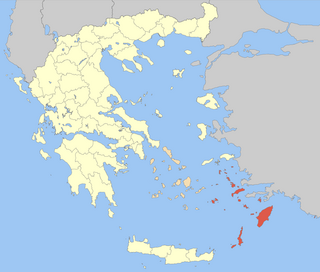
The Dodecanese are a group of 15 larger plus 150 smaller Greek islands in the southeastern Aegean Sea and Eastern Mediterranean, off the coast of Turkey's Anatolia, of which 26 are inhabited. This island group generally defines the eastern limit of the Sea of Crete. They belong to the wider Southern Sporades island group.
Commencing in 1332 the numerous Holy Leagues were a new manifestation of the Crusading movement in the form of temporary alliances between interested Christian powers. Successful campaigns included the capture of Smyrna in 1344, at the Battle of Lepanto in 1571 and the recovery of the Balkans between 1684 and 1697.

The Holy League of 1571 was arranged by Pope Pius V and included the major Catholic powers of southern Europe, specifically the Spanish Empire as well as the Italian maritime powers. It was intended to break the Ottoman Empire’s control of the eastern Mediterranean Sea and was formally concluded on 25 May 1571. Its members were:

The Aegean dispute is a set of interrelated controversies between Greece and Turkey over sovereignty and related rights in the region of the Aegean Sea. This set of conflicts has strongly affected Greek-Turkish relations since the 1970s, and has twice led to crises coming close to the outbreak of military hostilities, in 1987 and in early 1996. The issues in the Aegean fall into several categories:
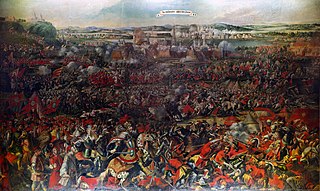
The Great Turkish War, also called the Wars of the Holy League, was a series of conflicts between the Ottoman Empire and the Holy League consisting of the Holy Roman Empire, Poland-Lithuania, Venice, Russia, and Habsburg Hungary. Intensive fighting began in 1683 and ended with the signing of the Treaty of Karlowitz in 1699. The war was a defeat for the Ottoman Empire, which for the first time lost large amounts of territory, in Hungary and the Polish–Lithuanian Commonwealth, as well as part of the western Balkans. The war was significant also by being the first time that Russia was involved in an alliance with Western Europe.

The Battle of Pente Pigadia or Battle of Beshpinar, took place on 24–30 October (O.S.), 1912. It was a battle fought between Greek forces under Lieutenant General Konstantinos Sapountzakis and Ottoman forces under General Esad Pasha during the First Balkan War. The battle began when the Ottomans attacked Greek positions at Anogi. Early snowfall prevented the Ottomans from launching a big offensive, while the Greeks managed to hold their ground for six days in the ensuing series of skirmishes.

The Battle of Sorovich took place between 22–24 October 1912 (O.S.). It was a battle fought between Greek and Ottoman forces during the First Balkan War, and revolved around the Sorovich area. The 5th Greek Division which had been advancing through western Macedonia separately from the bulk of the Hellenic Army, encamped at Sorovich where it found itself to be heavily outnumbered by an opposing Ottoman force.

Tzachas, also known as Chaka Bey was an 11th-century Seljuk Turkish military commander who ruled an independent state based in Smyrna. Originally in Byzantine service, he rebelled and seized Smyrna, much of the Aegean coastlands of Asia Minor and the islands lying off shore in 1088–91. At the peak of his power, he even declared himself Byzantine emperor, and sought to assault Constantinople in conjunction with the Pechenegs. In 1092, a Byzantine naval expedition under John Doukas inflicted a heavy defeat on him and retook Lesbos, while in the next year he was treacherously slain by his son-in-law Kilij Arslan I. Smyrna and the rest of Tzachas' former domain were recovered by the Byzantines a few years later, in c. 1097.

The Ottoman Navy, also known as the Ottoman Fleet, was the naval warfare arm of the Ottoman Empire. It was established after the Ottomans first reached the sea in 1323 by capturing Karamürsel, the site of the first Ottoman naval shipyard and the nucleus of the future Navy.

The Holy Leagueof 1684 was an alliance of European nations formed during the Great Turkish War. Born out of the Treaty of Warsaw, it was founded as a means to prevent further Ottoman expansion into Europe. This consolidation of a large portion of Europe's military might led to unprecedented military successes, with large areas of previously ceded land recovered in Morea, Dalmatia and Danubia in what has been dubbed a "14th crusade".

The Seleucid War, also known as the War of Antiochos or the Syrian War, was a military conflict between two coalitions led by the Roman Republic and the Seleucid Empire. The fighting took place in modern day southern Greece, the Aegean Sea and Asia Minor.

The Seventh Ottoman–Venetian War was fought between the Republic of Venice and the Ottoman Empire between 1714 and 1718. It was the last conflict between the two powers, and ended with an Ottoman victory and the loss of Venice's major possession in the Greek peninsula, the Peloponnese (Morea). Venice was saved from a greater defeat by the intervention of Austria in 1716. The Austrian victories led to the signing of the Treaty of Passarowitz in 1718, which ended the war.

Anacamptis sancta, also called the Holy orchid, is a species of orchid closely related to Anacamptis coriophora that is found in the eastern Mediterranean.
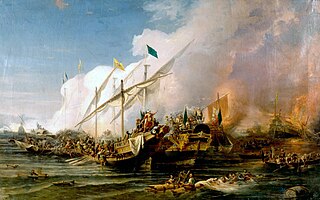
The Third Ottoman Venetian War (1537–1540) was one of the Ottoman–Venetian wars which took place during the 16th century. The war arose out of the Franco-Ottoman alliance between Francis I of France and Süleyman I of the Ottoman Empire against the Holy Roman Emperor Charles V. The initial plan between the two had been to jointly invade Italy, Francis through Lombardy in the North and Süleyman through Apulia to the South. However, the proposed invasion failed to take place.
The Battle of Chios was a naval battle fought off the shore of the eastern Aegean island of Chios between a Latin Christian—mainly Hospitaller—fleet and a Turkish fleet from the Aydinid emirate. The Christian fleet was resoundingly victorious, but for the Aydinids, who had been engaging in piracy since the collapse of Byzantine power, it was only a temporary setback in their rise to prominence.

Gregory VI, baptismal name Georgios Fourtouniadis was Ecumenical Patriarch in the periods 1835–1840 and 1867–1871.
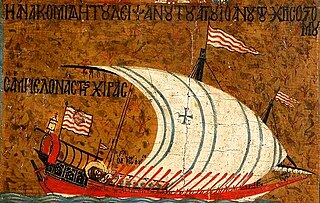
The Battle of Adramyttion occurred in autumn 1334 between the fleets of a Christian naval league, headed by the Republic of Venice and the Knights Hospitaller, and of the Turkish beylik of Karasi. The battle was a Christian victory.
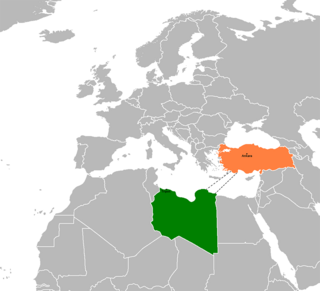
Turkey and the Government of National Accord (GNA) of Libya signed a Maritime Boundary Treaty in order to establish an Exclusive economic zone in the Mediterranean Sea, which meant that they could claim rights to ocean bed resources. According to the list of maritime boundary treaties, this was the first agreement ever to be signed between the two countries. However, fears were expressed that the agreement may fuel an "energy showdown" in this region, because it was highly contentious.
The Greek revolt of 1566–1572 was a series of conflicts between Greek rebels and the Ottoman Empire during the early period of Ottoman rule in the region. Social tensions intensified at the end of the 16th century by the debilitation of the Ottoman administration, the chronic economic crisis, and arbitrary conduct of the Ottoman state authorities. The leaders of the uprising were initially successful and controlled several strategic locations and fortresses, especially in Epirus, Central Greece, and the Peloponnese. However the movement lacked the necessary organization. They were assisted by western powers; mainly by the Republic of Venice. Meanwhile the victory of the Holy League against the Ottoman fleet in the Battle of Lepanto, in November 1571, triggered further revolutionary activity. However, Venice withdrew its support to the Greek rebels and signed a unilateral peace with the Ottomans. As such the rebellion was doomed to end and the Ottoman forces committed a number of massacres in the aftermath of the revolt during the suppression of the uprising. Throughout the pacification process, various primarily isolated areas were still out of Ottoman control and new rebellions erupted, like that of Dionysios Skylosophos in 1611.
















